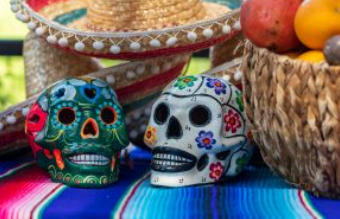“Our dead are never dead to us, until we have forgotten them.” -George Eliot. Dia de los Muertos is a Spanish holiday traditionally celebrated in Mexico. This holiday is celebrated on the first and second of November. Dia de los Muertos is very important to spanish communities and we will review the reasons why people celebrate this holiday, the food eaten on this special day, and the famous traditions.
People celebrate Dia de los Muertos to honor their dead family members. National Geographic Kids states, “The holiday, which is celebrated mostly in Mexico on November 1 and 2, is like a family reunion—except dead ancestors are the guests of honor. Day of the Dead is a joyful time that helps people remember the deceased and celebrate their memory.” Dia de los Muertos isn’t supposed to be sad. This holiday is to bring people together and remind them that their ancestors will always be with them mentally. The two days of this holiday doesn’t just celebrate dead people in general. November first celebrates deceased children and is often known as, ‘Dia de los Inocentes’ or ‘Dia de los Angelitos’. November second celebrates deceased adults. Clearly Dia de los Muertos is very important not only to the community, but to people who have lost their loved ones.
“Food connects the living and the dead during Dia de los Muertos.” The holiday, Dia de los Muertos, contains many tasty and traditional foods that are only eaten on that special day. Examples include pan de muerto, sugar skulls, and tamales. Pan de muerto is a sweet bread made mostly of flour, sugar, eggs, and butter. This traditional food is often placed on altars for loved ones. Sugar skulls are made up of sugar and water. These skulls are made to represent and honor people who have passed. Finally, tamales are a blend of pork, vegetables, and chicken wrapped in corn husks. Family’s will make this food together so they can spend quality time with their current loved ones. There are many types of foods eaten on this holiday and each one serves a special purpose for Dia de los Muertos.
Finally, Dia de los Muertos is known for it’s skulls. National Geographic Kids explains, “And don’t forget the skeletons. During Day of the Dead, life-size papier-mâché skeletons and miniature plastic or clay skeletons are everywhere. Why? Mexicans honor their ancestors on Day of the Dead, but they’re also reminding themselves that death is just a part of life. Hanging out with skeletons reminds people that one day they will be skeletons—but not for a very long time!” This holiday has skulls everywhere from people dancing as skulls to the foods like sugar skulls! Dia de los Muertos includes all of these skulls in different events to honor the people’s loved ones in a fun and entertaining way.
Dia de los Muertos is very important to spanish speaking communities because it honors people’s deceased loved ones, the food servse a purpose for celebrating the deceased and allows people to bond with their family members, and finally the skull theme reminds people that their loved ones will always be with them even though they aren’t physically with them. Without this holiday, people would forget their deceased ancestors, making them truly dead to them like George Eliot said. Lets keep the spirits alive and celebrate Dia de los Muertos together in November!
Works Cited
National Geographic Kids. “Day of the Dead.” National Geographic Kids, 28 Sept. 2016, kids.nationalgeographic.com/celebrations/article/day-of-the-dead. Accessed 25 Jan. 2025.
Acosta, Tiffany, and Dina Kaur. “What Is Day of the Dead? Ultimate Guide to Traditions, Dates and What Goes on an Altar.” The Arizona Republic, 20 Oct. 2023, www.azcentral.com/story/entertainment/holidays/2023/10/20/dia-de-los-muertos-day-of-the-dead-facts/70384393007/. Accessed 25 Jan. 2025.
Surfin’ Taco. “Day of the Dead Food: A Traditional Día de Los Muertos Feast.” Northshoretacos.com, North Shore Tacos, Oct. 2024, northshoretacos.com/news/food/dia-de-los-muertos. Accessed 25 Jan. 2025.
